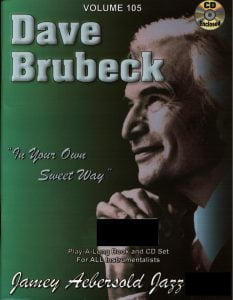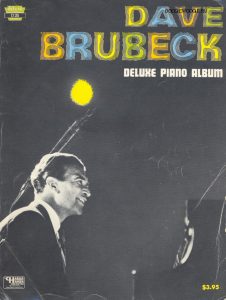Browse in the Library:
Or browse in the categories menus & download the Library Catalog PDF:
Dave Brubeck “In your own sweet way” (Jazz Play Along, Aebersold’s Volume 105) SHEET MUSIC
“In Your Own Sweet Way” is a tune written by the great pianist Dave Brubeck. It was written in 1952 with lyrics written by his wife Lola.
This tune has become a very well known jazz standard and is a great one to add to your repertoire.
Dave Brubeck
A great representative of the ‘West Coast Jazz’, Dave Brubeck’s first steps on the piano were taken with his mother, who had studied in the United Kingdom with Myra Hess and once pretended to be a soloist, but dedicated herself to giving piano lessons.
He was trained in academic music, but when he heard Ellington, he turned to jazz. Also, his older brothers were musicians, and it was in this context that he played already in his early youth in jazz venues. His father was a farmer, so he thought about being a veterinarian, and he attended college but ended up going to the conservatory at the ‘College of the Pacific’.

During World War I he was drafted into the US Army and served overseas in the Third Army. But he stopped being a soldier when, participating in a Red Cross concert, he was ordered to form a musical band due to its success: The Wolfpack, integrating white and black musicians.
At the end of the war he returned to study with the French composer Darius Milhaud, fugue and counterpoint, which he would imprint on his compositions, at Mills College in Oakland and on occasion with Arnord Schoenberg.
After forming an experimental octet and a trio in 1946, together with Cal Tjader (vibraphonist) and Don Crotty (bass), in 1951 he created the Dave Brubeck Quartet, where he found his musical identity. This occurs within the framework of a new stylistic movement: cool jazz, a name that remained for the musicians of the East Coast, based on musicians such as Lennie Tristano, a pianist from Chicago, and Miles Davis, who distanced himself from the bop that he played with Parker and records Birth of the Cool, in a more relaxed and orchestral style.
Another point of gravitation is West Coast Jazz, a current where Brubeck joins, developed on the western coast of the USA. It was often played by musicians who earned their living in the film orchestras of the big Hollywood studios. Elements of the musical tradition of academic Europe and Euro-American, African and Eastern folklore play an important role in this music.
The Dave Brubeck Quartet ventured into metrics that were far from jazz at the time, as well as their improvisations and harmonic approach, becoming one of the most famous groups within the genre, in counterpoint with the blues-influenced scene of New York and Philadelphia.
The quartet generated interest from both audiences and critics, although Brubeck failed to gain acceptance as a piano master in the jazz environment. His group reached No. 1 in Down Beat magazine—there were reports in Life and a cover in Time!—and he contributed to the popularity of jazz on college campuses in the 1950s, touring student unions before the genre was displaced by rock.

The most important point was the album Time out (1959, Columbia) together with Paul Desmond on alto sax, Eugene Wright on double bass and Joe Morello on drums. It sold more than a million copies, being a cross between the refined and exuberant, with unusual metrics in jazz compositions.
His most outstanding songs are “Take Five”, composed by Desmond in 5/4 time, which became a standard and a milestone, a popular phenomenon; “Blue Rondo a la Turk”, based on a Turkish rhythm; and “Pick Ups Steaks”. The album cover contains an avant-garde painting by artist Neil Fujita.
The overwhelming success of the song “Take Five”, composed in 5/4 time by saxophonist Paul Desmond, his partner in leading the quartet until its disbandment in 1967, often led to Brubeck and his understanding of jazz being misunderstood.
The composition became a standard adored by the masses, claimed for television tunes and massive sporting events, although viewed with suspicion by the most purist sector for its sensationalism, when the truth is that even today, with its mixture of experimentation and commercialism, it endures as one of the most fascinating songs of the genre.
Published by Columbia in 1959 as part of the Time out album, suitably adorned on its cover with an avant-garde painting, the ideal ingredient to complete the intellectual sophistication capable of seducing America prior to the hippie revolution, it was the first jazz album to reach a million copies sold. It also marked the culmination of the aspirations of the group that Brubeck had founded in the early 1950s with Desmond.
Other prominent albums are Time Further Out (1961), Countdown: Time in Outer Space (1962) and Time Changes (1964), with tapas by Joan Miró, Franz Kline and Sam Francis respectively. The same can be said of Time in (1966). On his part, the live album at Carnegie Hall (1963) represents another important milestone, particularly with his songs “In Your Own Sweet Way” and “The Duke.”
Best Sheet Music download from our Library.
In 1959 the DBQ played next to the New York Philharmonic, directed by Leonard Bernstein. They recorded Dialogues For Jazz Combo and Orchestra, composed of their brother Howard Brubeck -a pioneer experience in the combination of jazz with symphonic orchestras. He participated in world tours with the dance company of Murray Louis, relating jazz to modern dance. He also turned through the Middle East and Eastern Europe, until its dissolution in 1967.
Due to the intense tours, the US Department of State makes him its cultural ambassador. The massiveness of jazz, due to its originality and the possibility of reproduction, led to this appropriation by power, seeking to position the genre as American music that expressed ‘freedom’ during the Cold War.
Already in 1956 the Jazz Ambassadors program was created with this orientation, within the framework of which Brubeck made a tour in 1958 on the other side of the “Iron Wall”, passing through East Germany and Poland, as well as several countries from the Middle East. Many other leading jazz artists would participate in the program.
That his participation did not imply an uncritical acceptance of power in the northern colossus is seen with the 1961 album The Real Ambassadors, made by Dave and his wife Iola together with Louis Armstrong. There, the musicians threw some satirical lines about the Jazz Ambassadors program and took the opportunity to contrast the preaching of freedom with the denunciations of segregationism and racism within the United States, which always had Brubeck as a strong denouncer.
All in all, Brubeck will not detach himself from the State Department: in 1987 he composes a choral work for the visit of Pope John Paul II to San Francisco; and he plays in 1988 in Moscow for the summit between Reagan and Gorbachev. In particular, the artist was taken by power as an example of the success of the family man who could have been a rancher, but he achieved success with music.

Associated with the West Coast jazz movement, which came from California to offer a fresh and sunny counterpoint to the heavily blues-influenced night scenes of cities like New York and Philadelphia, the band made a name for itself thanks to his tours of the student associations of universities throughout the country, before jazz definitively lost its power to influence youth in favor of rock and roll.
Some of those concerts, collected on albums such as Jazz at Oberlin or Jazz at the College of the Pacific (both on the San Francisco Fantasy label), today shine like jewels for attentive fans. Although they were overshadowed by his later work, they served to make him the first modern jazz musician (and one of the few of all time and categories) to occupy the cover of Time magazine in November 1954.
In his 50-year career, Brubeck represented creative jazz, reaching its peak with his quartet, with its torrential improvisations, baroque and romantic quotes and extensive knowledge of classical and contemporary repertoire, passing away on December 5, 2012.
Browse in the Library:
Or browse in the categories menus & download the Library Catalog PDF:
